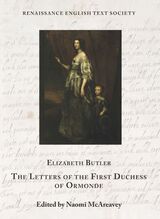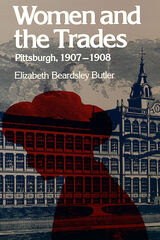2 books by Butler, Elizabeth

The Letters of the First Duchess of Ormonde
Elizabeth Butler
Iter Press, 2022
This volume is the first to bring together the entire extant correspondence of one of the most significant women in early modern Ireland, Elizabeth Butler, first Duchess of Ormonde. She was the wife of James Butler, twelfth Earl and first Duke of Ormonde, who, as Ireland’s only duke and three times its lord lieutenant, was a figure of considerable importance in seventeenth-century Ireland. But far from being overshadowed by her powerful husband, Butler was a person of significant power and influence in her own right. Descended from the tenth Earl of Ormonde, she brought a hefty portion of the Ormonde estate to the marriage. As Countess, Marchioness, then Duchess of Ormonde, as well as three times vicereine and a high-status courtier, she sat at the pinnacle of Irish and English society, unmatched by any other Irish woman of the period in terms of her wealth, social standing, and power. Her surviving correspondence reveals her importance within the Ormonde-Butler family and in the social, cultural, and political life of seventeenth-century Ireland.
The volume comprises more than three hundred letters written by Ormonde to her husband and family, agents and servants, and friends and clients. Spanning six decades, these letters are meticulously transcribed, edited, and annotated, and the volume includes a substantial scholarly introduction, family trees, a glossary, and other resources.
The volume comprises more than three hundred letters written by Ormonde to her husband and family, agents and servants, and friends and clients. Spanning six decades, these letters are meticulously transcribed, edited, and annotated, and the volume includes a substantial scholarly introduction, family trees, a glossary, and other resources.
[more]

Women and the Trades
Pittsburgh, 1907–1908
Elizabeth Beardsley Butler
University of Pittsburgh Press
Women and the Trades has long been regarded as a masterwork in the field of social investigation. Originally published in 1909, it was one of six volumes of the path breaking Pittsburgh Survey, the first attempt in the United States to study, systematically and comprehensively, life and labor in one industrial city. No other book documents so precisely the many technological and organizational changes that transformed women's wage work in the early 1900s.
Despite Pittsburgh's image as a male-oriented steel town, many women also worked for a living-rolling cigars, canning pickles, or clerking in stores. The combination of manufacturing, distribution, and communication services made the city of national economic developments.
What Butler found in her visits to countless workplaces did not flatter the city, its employers, or its wage earners. With few exceptions, labor unions served the interests of skilled males. Women's jobs were rigidly segregated, low paying, usually seasonal, and always insecure. Ethnic distinctions erected powerful barriers between different groups of women, as did status hierarchies based on job function.
Professor Maurine Weiner Greenwald's introduction provides biographical sketches of Butler and photographer Lewis Hine and examines the validity of Butler's assumptions and findings, especially with regard to protective legislation, women worker's “passivity,” and working-class family strategies.
Despite Pittsburgh's image as a male-oriented steel town, many women also worked for a living-rolling cigars, canning pickles, or clerking in stores. The combination of manufacturing, distribution, and communication services made the city of national economic developments.
What Butler found in her visits to countless workplaces did not flatter the city, its employers, or its wage earners. With few exceptions, labor unions served the interests of skilled males. Women's jobs were rigidly segregated, low paying, usually seasonal, and always insecure. Ethnic distinctions erected powerful barriers between different groups of women, as did status hierarchies based on job function.
Professor Maurine Weiner Greenwald's introduction provides biographical sketches of Butler and photographer Lewis Hine and examines the validity of Butler's assumptions and findings, especially with regard to protective legislation, women worker's “passivity,” and working-class family strategies.
[more]
READERS
Browse our collection.
PUBLISHERS
See BiblioVault's publisher services.
STUDENT SERVICES
Files for college accessibility offices.
UChicago Accessibility Resources
home | accessibility | search | about | contact us
BiblioVault ® 2001 - 2024
The University of Chicago Press









